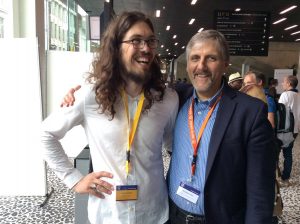With Indoor Air 2016 President Jelle Laverge (left)
Sitting in the Brussels airport waiting for my flight back to Texas I have had time to reflect on Indoor Air 2016. Indoor Air conferences are the premiere conferences for those of us around the globe who study indoor air quality. The conference series was started in 1978. Until 2014 in Hong Kong it was held every three years. It then went to a two-year cycle, and was just recently held in Ghent, Belgium. The University of Texas organized Indoor Air 2011 in Austin. The conference generally draws around 1,000 delegates, with perhaps ¼ being graduate students. The bulk of the remainder are faculty members at universities around the world, researchers in government labs, and a much smaller number of policymakers, industry staff, and consultants.
I am pleased and proud of the influence that the indoor air quality program at the University of Texas at Austin has made on our field, and the significant connections that we have made within the field. Our team’s attendance at Indoor Air 2016 was equivalent to that of a moderate-sized country. We sent a contingent of 10 delegates, roughly 1% of conference attendees from just one academic department. We were the only delegates from the State of Texas, and so we made sure that Texas pulled its weight at the conference. Our four Professors chaired sessions, served on panels, gave podium presentations, and were important contributors to workshops on cutting-edge issues in the field. Our two research engineers/scientists gave presentations and served as session chairs. And I am most proud of the four current students from our department who attended the conference, gave wonderful presentations, and served as ambassadors for our department and university. I received great feedback from those who interacted with our students and who observed them when they gave presentations on their research.
Our team presented cutting-edge research related to emissions and presence of endocrine disrupting chemicals in schools and other buildings, outdoor and indoor ozone concentrations in high schools in Texas, ventilation quality and accumulation of human breath in high school classrooms in Texas, particle concentrations in high school classrooms, oxygenated VOCs in high school classrooms, the microbiology of portable classrooms, and more. We also participated in sessions and workshops on the important topics of chemistry and microbiology of the built environment, sponsored by the Alfred P. Sloan Foundation.
But there were also many other connections to our program that were obvious at the conference. Many of our ex-students who are now in academia were present and made major contributions to Indoor Air 2011. As a product of the indoor air quality program at UT, their presence and performance made me glow with pride. These alumni included Dr. Chi Chi Lin (now a professor in Taiwan), Dr. Ellison Carter (Colorado State University), Dr. Donghyun Rim (Penn State University), Dr. James Lo (Drexel University), Dr. Brent Stephens (Illinois Institute of Technology), Dr. Brandon Boor (Purdue University), and Dr. Michael Waring (Drexel University). Dr. Dustin Poppendieck, also an alumnus of our department as a Ph.D. student, and later as post-doc and research engineer on my team, is now a highly-recognized indoor air quality engineer at NIST. Dustin was all over Indoor Air 2016, as speaker, session chair, poster-presenter, and all around catalyst for engaging discussions about indoor air quality research. Another graduate of our program, Dr. Shahana Khurshid, is also at NIST, doing research as a post-doctoral fellow. And to top this all off, Michael Waring and Brent Stephens were named President and Technical Chair of Indoor Air 2018 in Philadelphia. What an impact our alumni are making!
But it does not stop there. Many others at the conference have engaged in significant collaboration with our program. The President of Indoor Air 2016, Jelle Laverge (University of Ghent), spent several months in our lab working on his Ph.D. dissertation and doing cutting-edge research on exposure to pollutants in the sleep microenvironment. Keynote speaker Gabriel Beko (Danish Technical University) spent several months in our lab while completing his Ph.D. dissertation. Keynote speaker Jeffrey Siegel (U of Toronto) spent nearly 10 years as a faculty member in our program before moving to his current position in his native Canada. Jeff was also inducted into the prestigious ISIAQ Academy of Fellows. Outgoing President of the Board of Directors of the International Society for Indoor Air Quality and Climate (ISIAQ), Glenn Morrison, spent a nine-month sabbatical in our department. Closing keynote speaker Charlie Weschler (Rutgers University) has visited our program numerous times, and previously served as Chair of the External Advisory Committee for our highly successful NSF IGERT program on Indoor Environmental Science and Engineering. Prominent indoor air quality researcher Pawel Wargocki hosted my extended visits to the Technical University of Denmark, an institution for which I just participated as a signatory on a new student exchange program with our department. Keynote speaker Yinping Zhang (Tsinghua University) has also visited our lab several times and hosted me during a recent visit to Tsinghua University.
The list of connections with our Indoor Air Quality program could go on. As one prominent indoor air quality researcher from Lawrence Berkeley National Lab said to me during one of the conference breaks, “The University of Texas has taken over the field!” That’s a very kind overstatement. However, I am very, very proud of the major contributions that our students, alumni, research staff, and faculty are making to the very important field of indoor air quality. HookEm!

Leave a Reply